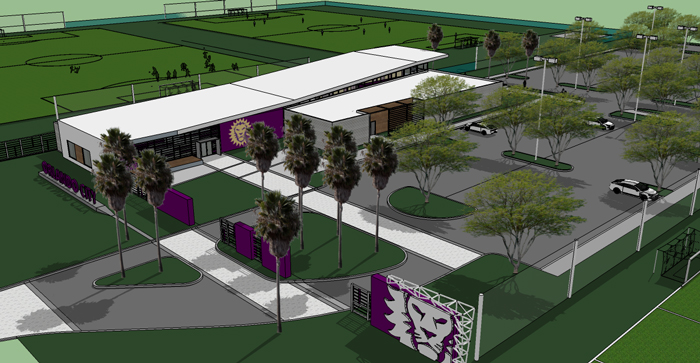
GOOD SPORTS
An emerging Sports & Performance District is reshaping Lake Nona, bringing world-class athletic facilities to the fast-growing community and taking the health-and-fitness orientation of its Medical City in a new direction.
Earlier this year, the USTA National Campus opened as the “Home of American Tennis” at Lake Nona, which has about 11,000 people in Orlando’s booming southeast quadrant and boasts the area’s top-selling residential developments.
As the anchor of the emerging sports district, the $70 million USTA National Campus brings together the association’s Community Tennis and Player Development divisions, along with the Florida branch of USTA and the national training site for USTA-certified officials.
It’s a place dedicated to learning, playing and improving the game. UCF’s varsity tennis programs will make it their home.
“It’s an incredible platform for us to raise the bar for how we deliver tennis,” says Kurt Kamperman, chief executive for community tennis at the USTA National Campus. “We’re using this campus truly as a campus — we want to train people who want to teach tennis, coach high-performance players, organize events.”
Despite its enormous size, the campus isn’t a concrete jungle. The association had plenty of land to separate courts, so ponds and landscaping contribute to a parklike setting. Kamperman sees the campus as a “metropolis” with smaller, self-sufficient neighborhoods devoted to different aspects of the game, such as family tennis.
Some of the courts are red clay, and the USTA found that the right clay was available only from Cremona, Italy — so it had 450 tons of the stuff shipped to Lake Nona.
All the courts have live streaming, Kamperman says. “So if a 14-year-old from Boston is playing a match and Grandma can’t come, she can watch it.” Some courts have more complex video systems that will help players analyze the strengths and weaknesses of their game.
More than 100 tennis tournaments and other events were planned for 2017 alone. More than 300 universities and colleges have already played at the USTA National Campus; more than 500 children a week participate in youth programs; and in the first six months, more than 50,000 people attended games, USTA spokeswoman Trina Singian said.
Current and former pros who visited the facility include Bob and Mike Bryan, Ivan Lendl, James Blake, Jack Sock, Bethanie Mattek-Sands, Madison Keys, Donald Young, CiCi Bellis and Frances Tiafoe.
Because Lake Nona offers easy access to adjacent Orlando International Airport and to S.R. 417, part of the beltway around Orlando, it’s easy for competitors and spectators to get to the facility from anywhere.
The nearby medical facilities offer plenty of synergies for sports organizations. For example Nemours, which operates a children’s hospital in Medical City, has partnered with the Andrews Institute for Orthopaedics & Sports Medicine, based near Pensacola, to become the official medical providers for the USTA National Campus.
Nearby, Orlando City Soccer Club is building its $20 million training center while working on a stadium in downtown Orlando. The Lake Nona facility will include a fitness center, clubhouse, locker rooms, offices and a rehabilitation center in addition to its six fields.
The Orlando City Lions (Major League Soccer), Orlando City B (United Soccer League), and the club’s Elite Youth Academy will train there.
Plus, plans are in the design stage for a beach volleyball complex on the shores of the private, 11-acre Crystal Lagoon for members of a luxury resort and spa. The resort and lagoon may break ground this winter, adjacent to the tennis complex.
And Tavistock is working to woo USA Rugby headquarters to Lake Nona, although more details were unavailable at presstime.
Rob Adams, Lake Nona’s vice president for development, sees the Sports & Performance District as a perk for Lake Nona residents and a draw for potential homebuyers.
“The USTA campus is really meaningful,” he says. “It’s a public facility, growing the sport of tennis across the board. It brings tennis to Orlando in a way that was previously unimaginable. With Orlando City soccer, you’ll see it enliven the community. You’ll see a desire to live near the center. You’ll see the faces of Orlando City throughout Lake Nona.”
Construction of medical and sports facilities makes a big statement, but a concern for healthy living was woven into all of Lake Nona — and it’s evident in more subtle ways, too.
The community ultimately will have 44 miles of trails for walking and biking, for example. And about 40 percent of its 11 square miles will remain undeveloped, creating open space that promotes a sense of wellbeing.
